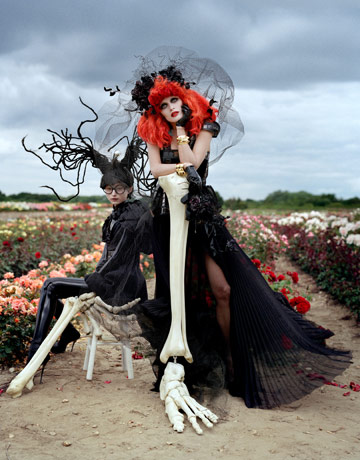
Over the years, the potent cinematic potion that is a Tim Burton movie has telegraphed Tim's darkly decadent visual sensibility to the outside world, and particularly to the world of art and fashion. As Kate Mulleavy (of the Rodarte design duo) observes, "I'm hard pressed to think of someone who works creatively and is not inspired by Tim Burton. Even if it's subconscious." In light of the recent release of Alice in Wonderland, let's take a little tour of its director's influence on style.
Burton has a gift for blending aesthetic registers that initially appear to be antithetical, but are later revealed to be deeply complementary. He specializes in the intersection between fear and comfort, corruption and innocence, sex and death, humor and horror. His name may call to mind black hues and deathly undertones, but it also conjures a whimsical world, flecked with splashes of bright color and even brighter imagination.
Which is the most fashionable of Burton's films? The answer depends on your personal preferences. If you have a soft spot for fast-talking ghosts with raccoon eyes, the orange hair of a punk teen, and a name that must be said in threes, then Beetlejuice (1988) is the one for you. If you prefer playboy industrialists who clunk around Gotham as masked bats in lacquered muscle tops, then Batman (1989) is your man.
If you're more in the market for delicate and wounded with a startling resemblance to Mina Loy, cutting instruments instead of digits, and a leather get-up that would make a BDSMer drool, then Edward Scissorhands (1990) is your bag, baby. If sultry, walking cadavers with big, dewy eyes and visible stitches do it for you, then The Nightmare Before Christmas (1993) and Corpse Bride (2005) are your best bets.
If you're seeking blonde, pneumatic alien chicks or a serial killer with a skunked 'do who reeks of Barbicide, then you should go for Mars Attacks! (1996) or Sweeney Todd (2007). If none of these capture your heart, then perhaps the thoroughly mad, anthropomorphic citizens of Alice in Wonderland's (2010) dream world are what you were holding out for. Either way, Alice does seem to be what the trend-makers were awaiting.
When I say that Burton has influenced fashion, I'm not just talking about how Mars Attacks! proved that nobody could capture the puke-green tones of tacky Martian chic better than he could. I'm also referring to Stella McCartney's Alice in Wonderland-inspired line for Disney and the Printemps department store in Paris asking Alexander McQueen, Christopher Kane, Maison Martin Margiela, Bernhard Willhelm, Haider Ackermann, and Manish Arora to design a one-off Alice dress in time for Paris Fashion Week.
Meanwhile, in the art world, New York's Museum of Modern Art is currently offering a retrospective of the dark director's work (November 22, 2009 through April 26, 2010). Displaying everything from childhood doodles to full-scale adult pieces, the exhibit amounts to a visual biography of Burton. The show simultaneously reflects the personal perspective of this surrealist pop artist and a broader sense of the impact he has had on the visual arts.
On the fashion front, with its ghostly, Baroque aura, it's not surprising that Burton's stylistic panache would resonate with such "Haute Goth" couturiers as Alexander McQueen and John Galliano. When it comes to Burton, there are the more overt fashion connections--as in the fact that I want to procure his address so that I can send him a Mr. Pearl corset--and the subtler ones.
The Burton effect can creep up on unsuspecting fashion lines, such as the love letter to the reptilian kingdom that is McQueen's 2010 spring collection (not to mention his apparent influence on the fanciful architectural excessof Lady Gaga, whose single premiered at the show). However, in the case of McQueen's 2008 fall collection, which positively bursts with a Burtonian bondage fairytale aesthetic, the connection is less tenuous.
As long as we're talking fashion, we have to acknowledge Burton's poshest accessory--the chiseled visage and acting chops of Sir Johnny Depp (I know, I know he hasn't been knighted, but he should be) that has graced seven of his films. Interestingly, Depp and Burton are both products of suburban alienation, and eventual mainstream acceptance for the very thing they were ostracized for to begin with--their wonderful strangeness. Perhaps as a result, both men have grown into adults with 20/20 child vision. They remain capable of seeing all the wondrous things that the other adults no longer can-- stricken as they are with a bad case of humbug. Because Burton was probably the kind of kid that wispy, gamine little girl children would tee-hee at, there is a sort of poetic justice to his influence on the world of fashion, dominated as it is by more leggy wonders than Edward could shake his scissors at.
In the end, the most striking fashion statement spawned by Alice in Wonderland comes from Burton himself. As a small taste of what was to come in Alice, he styled the October, 2009 Halloween issue of Harper's Bazaar. These photographs are out of this world. Shot by Tim Walker, each photograph is a nod to a character from a Burton film, featuring Rodarte, Louis Vuitton, YSL, Alexander McQueen, and Nina Ricci as co-imaginers. Perhaps because they promise a dream world of dark, twisted, sophistication so like that of fashion, visuals from Burton's films dance in designers' heads; and now I leave them to dance in yours.
(cross-posted at 212DressingRoom)